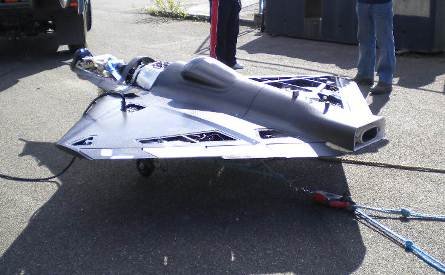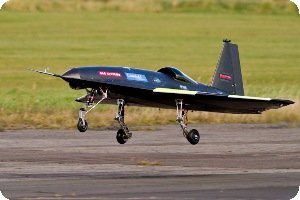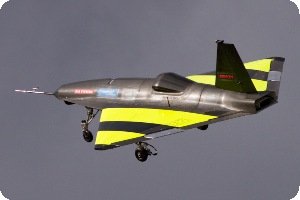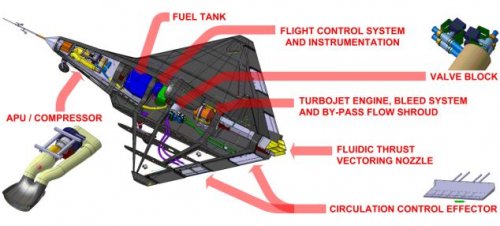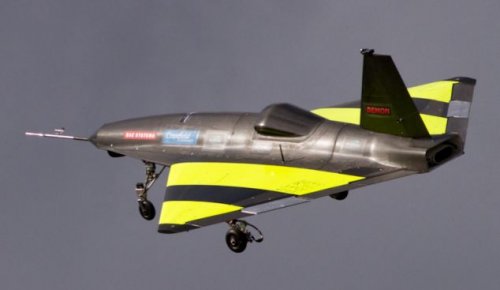You are using an out of date browser. It may not display this or other websites correctly.
You should upgrade or use an alternative browser.
You should upgrade or use an alternative browser.
BAe DEMON UAV demonstrator makes first flight
- Thread starter bobbymike
- Start date
saintkatanalegacy
Little Miss Whiffologist
- Joined
- 31 March 2009
- Messages
- 718
- Reaction score
- 17
any thoughts on how the plane works? ???
- Joined
- 27 December 2005
- Messages
- 17,748
- Reaction score
- 26,421
They are looking at thrust vectoring and circulation control, according to the website (http://www.flaviir.com/aerodynamics.htm)
I
Ian33
Guest
http://www.geocities.com/m_mason007/Paper.pdf
Fluidic thrust vecoring.
http://www.geocities.com/m_mason007/home.html
Fluidic thrust vecoring.
http://www.geocities.com/m_mason007/home.html
- Joined
- 2 August 2006
- Messages
- 3,255
- Reaction score
- 1,527
Maybe someone here can remember, I recall reading about circulation control technology that uses a porous material that basically makes parts of wings "invisible" to the air, but that is of course, a euphemism for letting the airflow through parts of the wing when you want it too. Do you think they are using that technology, or just bleed air from the engine? I was wondering if that's what the two whitish stripes near the trailing edge of the wing and the small white stripes on the leading edge are?
overscan said:They are looking at thrust vectoring and circulation control, according to the website (http://www.flaviir.com/aerodynamics.htm)
That would do the trick!
airrocket
Dreams To Reality
There are other ways even hypersonic applications which are flapless....
saintkatanalegacy
Little Miss Whiffologist
- Joined
- 31 March 2009
- Messages
- 718
- Reaction score
- 17
one prospective solution was on plasma surface control for hypersonic design
- Joined
- 4 May 2008
- Messages
- 2,439
- Reaction score
- 762
Article on Flightglobal about FLAVIIR
http://www.flightglobal.com/articles/2009/10/02/333030/ground-trials-start-for-uk-vectored-thrust-prototype-uav.html
http://www.flightglobal.com/articles/2009/10/02/333030/ground-trials-start-for-uk-vectored-thrust-prototype-uav.html
Attachments
- Joined
- 1 April 2006
- Messages
- 11,394
- Reaction score
- 10,302
27 Sep 2010 - Showcase UAV demonstrates 'Flapless Flight'
A novel unmanned air vehicle (UAV) which showcases a wide range of new technologies has successfully demonstrated ‘flapless flight’ in the UK.
The UAV, called DEMON, made the historic flight from an airfield at Walney Island in Cumbria on Friday 17 September. Developed by Cranfield University, BAE Systems, and nine other UK universities, DEMON is designed to be able to forgo the use of conventional mechanical elevators and ailerons which usually control the movement of an aircraft in favour of novel aerodynamic control devices using blown jets of air.
Such an approach offers several advantages over ‘moving flap’ technology which has been used since the early days of aviation, in that it means fewer moving parts, less maintenance, and a more stealthy profile for the aircraft. DEMON’s trial flights were the first ‘flapless flights’ ever to be authorised by the UK Civil Aviation Authority.
In Cumbria, DEMON successfully demonstrated flapless flight when, for a planned portion of a test-flight, the conventional flap control system was turned off and the aircraft flew and manoeuvred using the new technology. BAE Systems promoted the development of the £6.2m FLAVIIR (Flapless Air Vehicle Integrated Industrial Research) programme which led to the DEMON demonstrator after laying down a ‘Grand Challenge’ to UK universities five years ago.
Professor John Fielding, chief engineer and lead for the DEMON demonstrator team from Cranfield University, said: “To make an aircraft fly and manoeuvre safely without the use of conventional control surfaces is an achievement in itself; to do that while at the same time bringing together new construction techniques and new control mechanisms could be said to be over-ambitious – but we have done it. The DEMON UAV has been developed within a research programme but it is a representative, complex, high technology aircraft. Gaining approval from the CAA and flying it successfully has required great skill, dedication and patience by the team and they should be very proud of their achievement.”
Richard Williams, BAE Systems programme director for Future Capability, said: “What the FLAVIIR Team have achieved in such a short time is nothing short of remarkable. I was in Cumbria to watch DEMON fly and I feel sure I have witnessed a significant moment in aviation history.” He added: “What makes it even more poignant is that this is the result of British brains collaborating to produce world-leading technology. It, and other initiatives like it, will help ensure we maintain both a level of sovereign capability and a competitive edge.”
The flapless system, developed around a concept called fluidic flight control, was the result of collaborative work between Cranfield and Manchester universities together with BAE Systems' Advanced Technology Centre and was tested in wind tunnels and on models before the full-scale trials on DEMON took place.
While Demon itself is not expected to become a production aircraft, a number of the technologies it contains have and will continue to filter through to a range of other aviation platforms.
ENDS
Further information
The programme to develop the aircraft and its technologies has been jointly funded by BAE Systems and the Engineering and Physical Sciences Research Council (EPSRC). As well as the successful demonstration of flapless flight technology, the programme also showcases new methods of UAV construction, new control systems, and more advanced integration of technologies.
The FLAVIIR programme will help inform the development of affordable and low-maintenance UAVs for the future and provides valuable information on the fluid dynamics of flight and the potential for low observability. As well as Cranfield University and BAE Systems, DEMON was developed in conjunction with the Imperial College of Science, Technology and Medicine; Leicester; Liverpool, Manchester; Nottingham; Southampton; Swansea; Warwick and York universities.
DEMON Key Facts:
Weight: 200 lbs (90 kg); Dimensions:approximately 8-foot (2.5m) wingspan Flight speed 70 -150kts.
It was developed by BAE Systems and Cranfield University in the UK. It incorporates fluidic flight controls developed at Cranfield and Manchester Universities and flight control algorithms developed at Leicester University and Imperial College
The DEMON is designed to fly with no conventional elevators or ailerons, getting its pitch and roll control from technologies which rely on blown air and so requires much fewer moving parts, therefore making it a lot easier to maintain and repair.
DEMON can fly parts of its mission by itself but, as it is currently an experimental vehicle, is not fully autonomous unlike, for example, BAE Systems’ MANTIS.
The shape of the DEMON aircraft is referred to as a "blended wing-body" configuration.
Cranfield University is a wholly postgraduate institution with a worldwide reputation for excellence and expertise in aerospace, automotive, defence, engineering, environment and water, health, management and manufacturing. The University is made up of the following Schools: Cranfield Health, School of Management, School of Applied Sciences, School of Engineering, and Cranfield Defence and Security at Shrivenham. For more information visit www.cranfield.ac.uk
BAE Systems is a global defence, security and aerospace company with approximately 107,000 employees worldwide. The Company delivers a full range of products and services for air, land and naval forces, as well as advanced electronics, security, information technology solutions and customer support services. In 2009 BAE Systems reported sales of £22.4 billion (US$ 36.2 billion).
For further information please contact: Naomie Stanford-Jones, Media Relations Executive, Cranfield University, tel: +44 (0) 1234 754999
Media Relations – Corporate Communications
Building 30
Cranfield University
Cranfield
Bedfordshire MK43 0AL
Tel: +44 (0) 1234 754999
Fax: +44 (0) 1234 758051
Email: mediarelations@cranfield.ac.uk
Website: www.cranfield.ac.uk
Simon Shrouder, BAE Systems, tel: +44 (0) 1772 856525 E: simon.shrouder@baesystems.com
Press release number: PR-20-10-SOE
http://www.cranfield.ac.uk/news/pressreleases/2010/page50603.html
A novel unmanned air vehicle (UAV) which showcases a wide range of new technologies has successfully demonstrated ‘flapless flight’ in the UK.
The UAV, called DEMON, made the historic flight from an airfield at Walney Island in Cumbria on Friday 17 September. Developed by Cranfield University, BAE Systems, and nine other UK universities, DEMON is designed to be able to forgo the use of conventional mechanical elevators and ailerons which usually control the movement of an aircraft in favour of novel aerodynamic control devices using blown jets of air.
Such an approach offers several advantages over ‘moving flap’ technology which has been used since the early days of aviation, in that it means fewer moving parts, less maintenance, and a more stealthy profile for the aircraft. DEMON’s trial flights were the first ‘flapless flights’ ever to be authorised by the UK Civil Aviation Authority.
In Cumbria, DEMON successfully demonstrated flapless flight when, for a planned portion of a test-flight, the conventional flap control system was turned off and the aircraft flew and manoeuvred using the new technology. BAE Systems promoted the development of the £6.2m FLAVIIR (Flapless Air Vehicle Integrated Industrial Research) programme which led to the DEMON demonstrator after laying down a ‘Grand Challenge’ to UK universities five years ago.
Professor John Fielding, chief engineer and lead for the DEMON demonstrator team from Cranfield University, said: “To make an aircraft fly and manoeuvre safely without the use of conventional control surfaces is an achievement in itself; to do that while at the same time bringing together new construction techniques and new control mechanisms could be said to be over-ambitious – but we have done it. The DEMON UAV has been developed within a research programme but it is a representative, complex, high technology aircraft. Gaining approval from the CAA and flying it successfully has required great skill, dedication and patience by the team and they should be very proud of their achievement.”
Richard Williams, BAE Systems programme director for Future Capability, said: “What the FLAVIIR Team have achieved in such a short time is nothing short of remarkable. I was in Cumbria to watch DEMON fly and I feel sure I have witnessed a significant moment in aviation history.” He added: “What makes it even more poignant is that this is the result of British brains collaborating to produce world-leading technology. It, and other initiatives like it, will help ensure we maintain both a level of sovereign capability and a competitive edge.”
The flapless system, developed around a concept called fluidic flight control, was the result of collaborative work between Cranfield and Manchester universities together with BAE Systems' Advanced Technology Centre and was tested in wind tunnels and on models before the full-scale trials on DEMON took place.
While Demon itself is not expected to become a production aircraft, a number of the technologies it contains have and will continue to filter through to a range of other aviation platforms.
ENDS
Further information
The programme to develop the aircraft and its technologies has been jointly funded by BAE Systems and the Engineering and Physical Sciences Research Council (EPSRC). As well as the successful demonstration of flapless flight technology, the programme also showcases new methods of UAV construction, new control systems, and more advanced integration of technologies.
The FLAVIIR programme will help inform the development of affordable and low-maintenance UAVs for the future and provides valuable information on the fluid dynamics of flight and the potential for low observability. As well as Cranfield University and BAE Systems, DEMON was developed in conjunction with the Imperial College of Science, Technology and Medicine; Leicester; Liverpool, Manchester; Nottingham; Southampton; Swansea; Warwick and York universities.
DEMON Key Facts:
Weight: 200 lbs (90 kg); Dimensions:approximately 8-foot (2.5m) wingspan Flight speed 70 -150kts.
It was developed by BAE Systems and Cranfield University in the UK. It incorporates fluidic flight controls developed at Cranfield and Manchester Universities and flight control algorithms developed at Leicester University and Imperial College
The DEMON is designed to fly with no conventional elevators or ailerons, getting its pitch and roll control from technologies which rely on blown air and so requires much fewer moving parts, therefore making it a lot easier to maintain and repair.
DEMON can fly parts of its mission by itself but, as it is currently an experimental vehicle, is not fully autonomous unlike, for example, BAE Systems’ MANTIS.
The shape of the DEMON aircraft is referred to as a "blended wing-body" configuration.
Cranfield University is a wholly postgraduate institution with a worldwide reputation for excellence and expertise in aerospace, automotive, defence, engineering, environment and water, health, management and manufacturing. The University is made up of the following Schools: Cranfield Health, School of Management, School of Applied Sciences, School of Engineering, and Cranfield Defence and Security at Shrivenham. For more information visit www.cranfield.ac.uk
BAE Systems is a global defence, security and aerospace company with approximately 107,000 employees worldwide. The Company delivers a full range of products and services for air, land and naval forces, as well as advanced electronics, security, information technology solutions and customer support services. In 2009 BAE Systems reported sales of £22.4 billion (US$ 36.2 billion).
For further information please contact: Naomie Stanford-Jones, Media Relations Executive, Cranfield University, tel: +44 (0) 1234 754999
Media Relations – Corporate Communications
Building 30
Cranfield University
Cranfield
Bedfordshire MK43 0AL
Tel: +44 (0) 1234 754999
Fax: +44 (0) 1234 758051
Email: mediarelations@cranfield.ac.uk
Website: www.cranfield.ac.uk
Simon Shrouder, BAE Systems, tel: +44 (0) 1772 856525 E: simon.shrouder@baesystems.com
Press release number: PR-20-10-SOE
http://www.cranfield.ac.uk/news/pressreleases/2010/page50603.html
Attachments
flateric,
They had a report on this on my local BBC tv North-West Tonight news programme tonight.
Most of it was what you just said, but they had film of it flying around too.
Also.....
http://www.dailymail.co.uk/sciencetech/article-1315570/Unmanned-jet-aircraft-world-fly-flaps.html
There is what the newspaper calls a tech diagram of how it all works, and further down the page a YouTube video.....
http://www.youtube.com/v/FqnAm0rPEJ4&rel=0&hl=en_US&feature=player_embedded&version=3
Regards,
Gerard
They had a report on this on my local BBC tv North-West Tonight news programme tonight.
Most of it was what you just said, but they had film of it flying around too.
Also.....
http://www.dailymail.co.uk/sciencetech/article-1315570/Unmanned-jet-aircraft-world-fly-flaps.html
There is what the newspaper calls a tech diagram of how it all works, and further down the page a YouTube video.....
http://www.youtube.com/v/FqnAm0rPEJ4&rel=0&hl=en_US&feature=player_embedded&version=3
Regards,
Gerard
Matej
Multiuniversal creator
Kryptid
ACCESS: Secret
- Joined
- 12 March 2009
- Messages
- 282
- Reaction score
- 52
A very interesting program indeed.
I can see this as being a pretty useful technology for future aircraft designs...assuming that an engine stall wouldn't render the aircraft uncontrollable. I see that the APU is shown on the diagram; might that mean the APU can power the air jets if the engine dies?
I suppose that conventional control surfaces could be used as a back-up, but that would eliminate the advantage of "fewer moving parts, less maintenance, and a more stealthy profile".
I can see this as being a pretty useful technology for future aircraft designs...assuming that an engine stall wouldn't render the aircraft uncontrollable. I see that the APU is shown on the diagram; might that mean the APU can power the air jets if the engine dies?
I suppose that conventional control surfaces could be used as a back-up, but that would eliminate the advantage of "fewer moving parts, less maintenance, and a more stealthy profile".
- Joined
- 21 December 2006
- Messages
- 1,243
- Reaction score
- 1,095
BBC report mentioned by Gerard above:
http://www.bbc.co.uk/news/uk-england-11431662
http://www.bbc.co.uk/news/uk-england-11431662
- Joined
- 21 December 2006
- Messages
- 1,243
- Reaction score
- 1,095
BAE website:
http://www.baesystems.com/AboutUs/ShowcaseUAVDemonstratesFlaplessFlight/index.htm
Paper looking at design and development:
http://www.icas-proceedings.net/ICAS2008/PAPERS/316.PDF
Research programme brochure:
http://www.flaviir.com/flaviir_brochure.pdf
http://www.baesystems.com/AboutUs/ShowcaseUAVDemonstratesFlaplessFlight/index.htm
Paper looking at design and development:
http://www.icas-proceedings.net/ICAS2008/PAPERS/316.PDF
Research programme brochure:
http://www.flaviir.com/flaviir_brochure.pdf
red admiral
ACCESS: Top Secret
- Joined
- 16 September 2006
- Messages
- 1,805
- Reaction score
- 2,377
Kryptid said:I can see this as being a pretty useful technology for future aircraft designs...assuming that an engine stall wouldn't render the aircraft uncontrollable. I see that the APU is shown on the diagram; might that mean the APU can power the air jets if the engine dies?
Quite possibly. I was talking to the team at Farnborough earlier in the year. The engine bleed air to the control surfaces is only a couple of percent. I wouldn't think engine stall would have been too much of a problem. It's not a high alpha vehicle. You're going to be cruising around at a fair altitude and should have time to restart the engine.
Similar threads
-
-
British Aerospace Jetstream 31 G-BWWW Flying Testbed
- Started by donaldson1
- Replies: 3
-
New X Plane: Lockheed Martin X-56 MUTT (Multi-Utility Technology Testbed)
- Started by Mike Pryce
- Replies: 48
-
-

